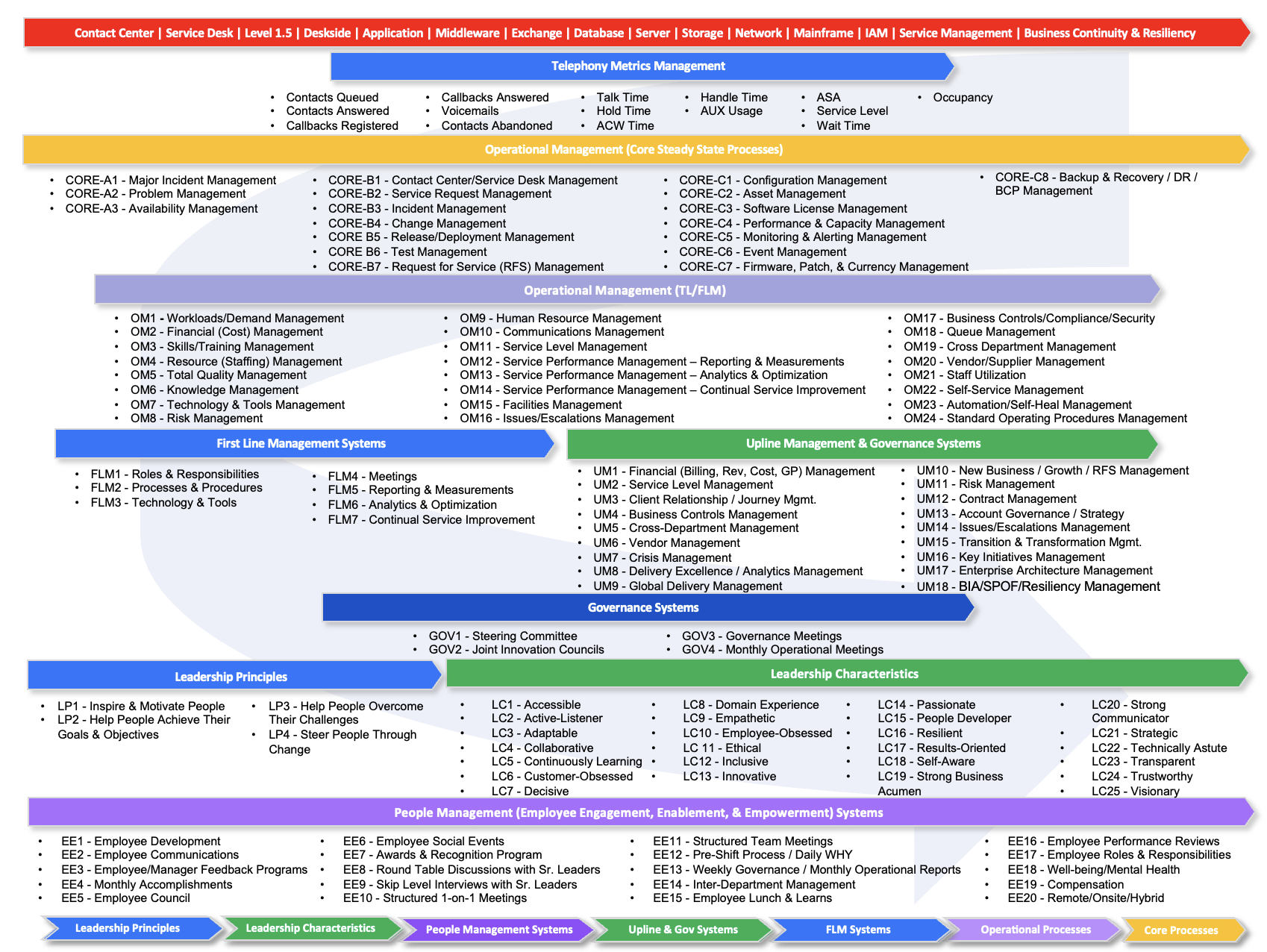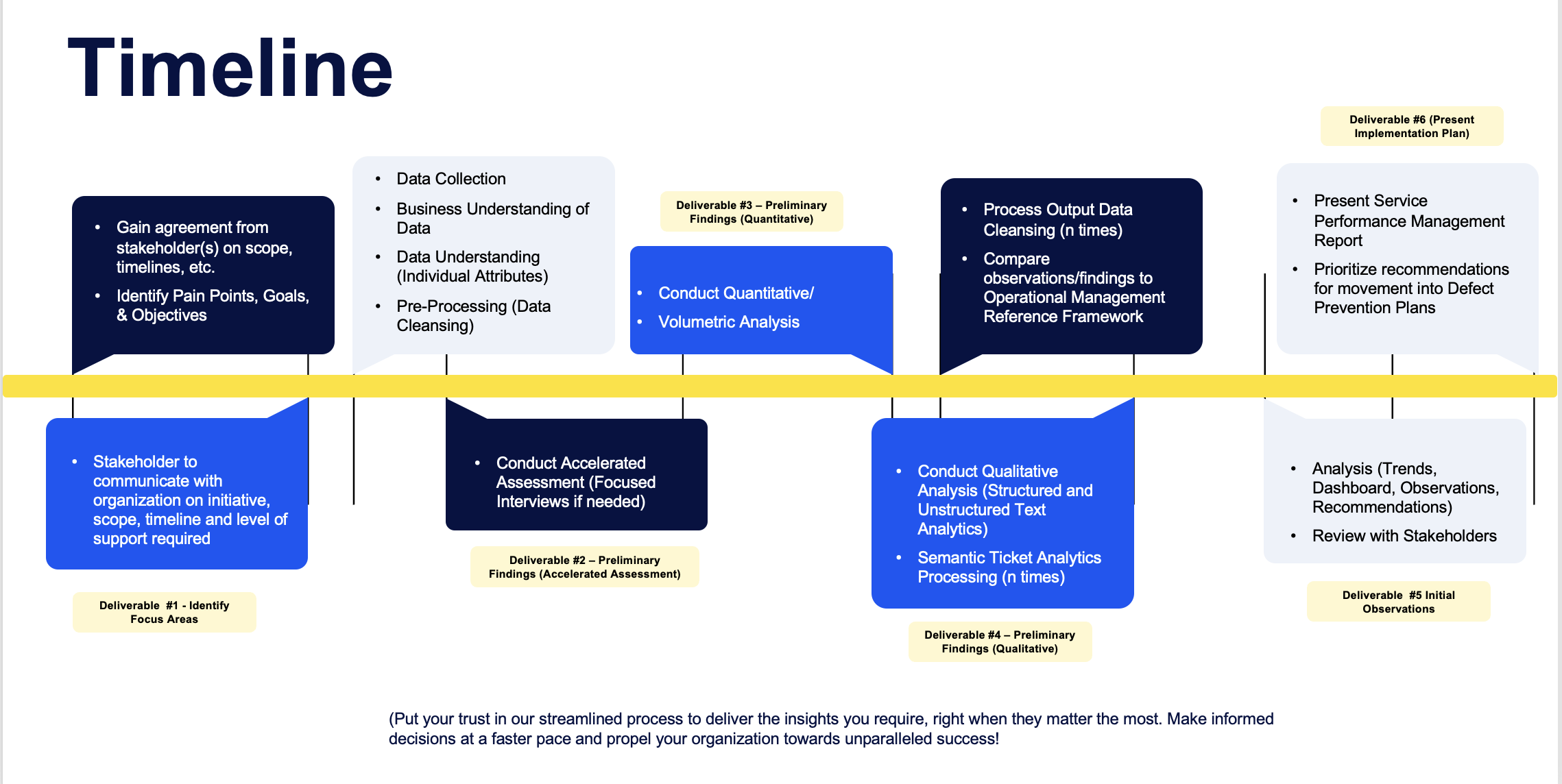We’ve talked to your peers. We know what senior leaders like you care about — and everything we assess ties directly back to those goals.
 Reduce Service Disruptions
Reduce Service Disruptions
- Address Repeat/Chronic Issues
- Strengthen Proactive Problem Management
- Review Monitoring Thresholds
- Address Performance & Capacity Issues
- Address Firmware, Patch, & Currency Management Issues
 Improve Client Experience
Improve Client Experience
- Improve Client Uptime And Availability
- Address Backlog Issues
- Address Repeat Issues
- Improve First Call Resolution
- Reduce L2+ Teams
 Improve Response/Resolution Time
Improve Response/Resolution Time
- Improve Triage/Ticket Documentation
- Improve Technical Teams Response Times
- Establish Escalation Process For Compliance Issues
- Round The Clock SME Coverage
- Empower MIO & IM
We Heard You
Your ITSM data is talking. Here’s how Ticket Analytics helps.
“Tickets close on time, yet clients still complain. We’ll show you why—and how to fix it.”
When You Don’t Stay on Top of Tickets, This Happens
Ticket-Level Symptoms
- Incident: Rising MTTA/MTTR, long unassigned dwell time, ping-pong reassignments, vague descriptions, priority mis-set, SLA Hold misuse, high reopen/premature closure rates.
- Problem: Chronic repeats with stale PRBs, weak RCA quality, actions not implemented/verified, change collisions not logged.
- Change: High urgent/expedited volume, failed/rollback changes, CAB bypass, poor risk/test evidence, post-change incident spikes.
- Service Request: Aging approvals/fulfillment stages, batching delays, unclear catalog items/ownership, frequent rework at closure.
- Service Desk: High wait/abandon, low FCR, misroutes and high dispatch, QA defects, duplicate/duplicate-of tickets.
Structural Causes We Surface
- Process & Triage Design: Unclear assignment rules, weak intake diagnostics, no backlog/aging hygiene or reopen review.
- Taxonomy & Data Quality: Inconsistent categories/CI & impact/priority, missing INC↔PRB↔CHG links, time-zone & duplicate data issues.
- Staffing & Shifts: Coverage gaps at handoff, queue ownership ambiguity, limited L2/L3 availability during peak hours.
- Tooling & Automation: Misconfigured routing/auto-assign, noisy/ineffective alerts, SLAs/OLAs not aligned to reality, low use of templates & guided diagnostics.
- Governance & Accountability: Weak escalation paths, PIR discipline missing, no SLOs for quality (reopens, bounce loops, documentation).
- Knowledge & Self-Service: Outdated articles, low deflection, scripts not embedded in forms, poor survey integrity.
- Reporting Blind Spots: “All green” dashboards hide tails—no percentile/cohort views, no backlog-aging segmentation or hour-by-hour heatmaps.
These aren’t isolated fires — they’re measurable patterns. Our ITSM Ticket Analytics pinpoints exactly where work stalls and why, then prioritizes fixes that cut MTTR, shrink backlog age, and lift CSAT.
How We Analyze Your ITSM Tickets for Operational Excellence
We apply a structured analytics model to your Incident, Problem, Change, and Service Request data to reveal where delay, rework, risk, and experience gaps originate—then map fixes that improve MTTA/MTTR, backlog age, and CSAT.

⏱️ Flow & Delay Metrics
Quantify response/resolve times, unassigned dwell, handoffs, queue aging by hour/team/site, and SLA Hold usage to pinpoint where work waits and why.
🧩 Incident & Problem Quality
Detect mis-categorization, ping-pong reassignments, reopen/premature-closure patterns, chronic categories, and RCA follow-through to cut rework.
🛠️ Change Impact & Risk
Link changes to incidents; track urgent/expedited volume, failure/rollback rates, CAB bypass, and test/risk evidence to reduce change-induced outages.
📦 Service Request Throughput
Analyze approval/fulfillment SLAs, batching delays, catalog clarity, ownership, and closure rework to improve request cycle time.
🌟 Experience, Governance & Outcomes
Align CSAT/feedback with ticket quality, validate survey integrity, and expose reporting blind spots—so “green dashboards” match real user experience.
Our Analytical Methods: Turning Data Into Insight
We apply a multi-faceted analytics approach to your ticket data—combining statistical, behavioral, and predictive methods to uncover the *why* behind delays, rework, and client dissatisfaction.
⏱️ Switch Analytics
Identify peaks and bottlenecks in call volumes, queue transitions, and response patterns across your ITSM channels.
📈 Time Series Analytics
Trend MTTR, reopen, and backlog metrics over time to pinpoint patterns tied to releases, staffing, or seasonality.
👥 Client Analytics
Profile ticket behavior by client, segment, or geography to understand who experiences the most delays and why.
💬 Client Experience Analytics
Correlate CSAT and survey data with ticket attributes to surface friction points invisible in SLA reports.
🏷️ Categorical Analytics
Evaluate the impact of categorization and assignment accuracy on efficiency and problem recurrence.
📊 Descriptive Analytics
Summarize what’s happening in your operations—volume, backlog age, handoffs, and triage outcomes—at every level.
🧑🔧 Technician / Tower Analytics
Assess team productivity, load balancing, and technical handoffs to uncover skill gaps or misaligned ownership.
🚀 Dispatch Analytics
Track ticket assignment and dispatch efficiency to identify lag between ticket creation and first engagement.
📂 Backlog Analytics
Analyze backlog composition, queue age distribution, and ownership duration to manage long-running tickets.
⚙️ Automation Analytics
Identify automation opportunities by isolating repetitive steps, missed triggers, or manual dependencies.
💭 Sentiment & Semantic Analytics
Leverage language models to interpret ticket notes, survey comments, and escalation text for tone and intent.
🔮 Predictive Analytics
Use machine learning to forecast volume surges, SLA risk, and incident recurrence for proactive mitigation.
How Our Ticket Analytics Engagement Works
We use a focused 4-step process to extract insights from your ITSM data, visualize patterns that drive delay and rework, and deliver a prioritized action plan that improves MTTA/MTTR, backlog age, and CSAT.
Discover
Ingest ticket exports (INC/PRB/CHG/SR), SLAs, survey samples, and resolver hierarchy. Align taxonomy, time zones, and data quality.
Analyze
Apply flow, backlog, categorical, change-impact, and semantic methods to uncover delay drivers, misroutes, reopen loops, and risk hot spots.
Visualize
Publish heatmaps, trend scorecards, and queue aging views by team/shift/category—so leaders can see where work waits and why.
Recommend
Deliver a ranked roadmap (8–15 actions) with owners, effort, and impact—targeting faster resolution, smaller backlogs, and better experience.
How Long Will the Ticket Analytics Engagement Take?
Assessing the time investment to transform your ITSM data into actionable insights

⏱️4–8 Week Standard Delivery: We deliver in-depth ticket analytics within 4–8 weeks—providing visibility into trends, bottlenecks, and improvement opportunities without delay.
🧩Flexible Timelines Tailored to You: Engagements can be accelerated or extended based on data complexity, system access, and your team’s availability—without compromising analytical depth.
🎯Our structured yet adaptable process ensures you receive insights when they matter most—empowering data-driven decisions that reduce MTTR, optimize effort, and elevate client experience.
Sample Ticket Analytics Output — Heatmap by Operational Area
Data-driven findings with Red/Amber/Green status and prioritized recommendations.
| Key Theme | Summary of Finding | RAG | Recommendation |
|---|---|---|---|
| Processes & Procedures | Major Incident Management | Red | Stabilize MIM: define on-call matrix, tighten comms cadence, add duty-manager alerts; target −40% P1 MTTR. |
| Processes & Procedures | Incident Management | Amber | Reduce delay & rework: fix intake template, auto-route by category/site, review reopen loops weekly; clean up SLA-Hold misuse. |
| Processes & Procedures | Problem Management | Red | Improve RCA throughput: age-based PRB queue, link INC→PRB→CHG, enforce action verification; target −30% repeat incidents. |
| Processes & Procedures | Change Management | Red | Control change risk: reduce urgent/expedited, pre-CAB fast track with guardrails, mandatory PIR for failures; track change-induced incidents. |
| Processes & Procedures | Knowledge Management | Amber | Boost deflection/FCR: curate top 30 articles, embed diagnostics in forms, add feedback loop; monitor article usage vs reopen rate. |
| Processes & Procedures | Skills Management | Amber | Close skill gaps: heatmap by team/shift; targeted coaching where reopen/bounce loops cluster. |
| Processes & Procedures | Service Performance — Reporting & Measurements | Amber | Expose the tails: add percentile/aging views, hour-by-hour heatmaps, and cohort tracking; retire “all-green” dashboards. |
| Technology & Tools | Monitoring & Alerting | Red | Reduce noise & misses: tune thresholds, deduplicate alerts, link alerts to INCs; measure alert→incident precision/recall. |
| Technology & Tools | Reporting / Analytics Platform | Amber | Centralize analytics: standardized model for MTTA/MTTR, backlog age, reopens, change collisions; single source of truth. |
| Technology & Tools | Automation | Amber | Prioritize quick wins: auto-triage, assignment rules, approval reminders, closure checks; track % tickets auto-handled. |
| Management & Governance | Weekly Service Performance | Amber | Institutionalize review: weekly hotspots (queues, hours, categories) with actions/owners; publish scorecard. |
| Management & Governance | Governance & Escalation | Amber | Clarify ownership: SLA for handoffs, duty-manager coverage at peaks, explicit reopen accountability. |
| Management & Governance | Monthly MOR | Amber | Connect ops to outcomes: tie improvements to cost/experience KPIs; track realized impact vs plan. |
Deliverables That Drive Real Change
Concrete outputs from our Ticket Analytics engagement—built to move MTTR, backlog age, and CSAT.
Insightful Findings
Data-backed observations that pinpoint delay drivers—misroutes, handoffs, reopen loops, SLA-Hold misuse, and surge windows.
Heatmaps & Dashboards
Queue-aging, hour-by-hour, and team/cohort views—so leaders can see where work waits and why.
Root Cause Analysis
Correlate INC↔PRB↔CHG, identify change-induced incidents, and validate RCA follow-through to stop repeats.
Maturity Snapshot (Optional)
Lightweight score across Operations, People, Tools, and Leadership to frame change readiness.
Prioritized Recommendations
8–15 actions ranked by impact and effort—covering intake, routing, knowledge, change risk, and automation.
90-Day Action Plan
A pragmatic roadmap with owners and milestones—quick wins first, then structural fixes.
Optional Enablement
Implementation support, coaching, and MOR (Monthly Ops Review) cadence to sustain improvements.
Tangible Results from Ticket Analytics
30%
Reduction in
Incident Volumes
Fewer recurring incidents and faster first-time fixes from better triage accuracy.
CSAT Increased
from 65% to 90%+
Analytics revealed root causes of poor experience and enabled measurable service quality gains.
70% Faster
Resolution of P1 Issues
Bottlenecks in assignment and escalation loops were removed through predictive analytics.
Contact Us To Get Started!
Unlock your team’s potential and elevate their performance through our ITSM Analytics Assessment!
Contact Us:
Email: info@jnanaanalytics.com
Phone: +1-249-288-1493
Website: https://www.jnanaanalytics.com
Please feel free to reach out to us for any inquiries, questions, or collaboration opportunities.
We look forward to hearing from you!
Take advantage of our exclusive offer for a free, limited assessment. Contact us today!